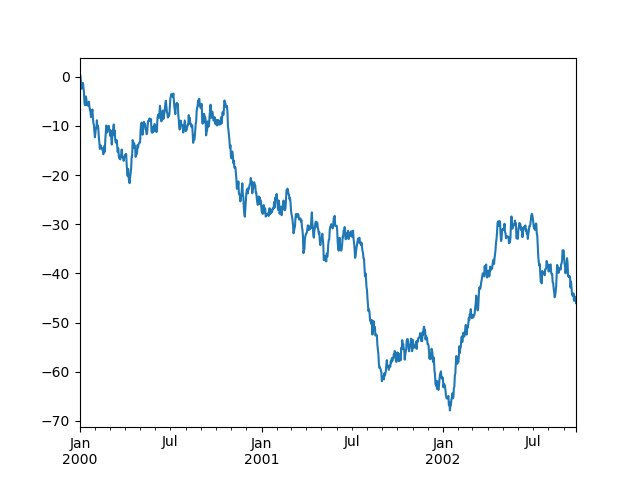Pandasis a Python package providing fast, flexible, and expressive data structures designed to make working with “relational” or “labeled” data both easy and intuitive. It aims to be the fundamental high-level building block for doing practical,real worlddata analysis in Python. Additionally, it has the broader goal of becomingthe most powerful and flexible open source data analysis / manipulation tool available in any language. It is already well on its way toward this goal.
pandas is well suited for many different kinds of data:

- Tabular data with heterogeneously-typed columns, as in an SQL table or Excel spreadsheet
- Ordered and unordered (not necessarily fixed-frequency) time series data.
- Arbitrary matrix data (homogeneously typed or heterogeneous) with row and column labels
- Any other form of observational / statistical data sets. The data actually need not be labeled at all to be placed into a pandas data structure
The two primary data structures of pandas, Series(1-dimensional) and DataFrame(2-dimensional), handle the vast majority of typical use cases in finance, statistics, social science, and many areas of engineering. For R users, DataFrame provides everything that R’sdata.frameprovides and much more. pandas is built on top of NumPyand is intended to integrate well within a scientific computing environment with many other 3rd party libraries.
10 Minutes to Pandas tutorial - tonumpy does not exist? Ask Question Asked 2 years, 2 months ago. Active 1 year, 11 months ago. Viewed 34k times 25. Pandas in 10 minutes by Wes McKinney www.pydata.orgPyData is an educational program of NumFOCUS, a 501(c)3 non-profit organization in the United States. 10-minute tour of pandas from Wes McKinney on Vimeo. Mon 11 February 2013.
Here are just a few of the things that pandas does well:
- Easy handling of missing data (represented as NaN) in floating point as well as non-floating point data
- Size mutability: columns can be inserted and deleted from DataFrame and higher dimensional objects
- Automatic and explicit data alignment: objects can be explicitly aligned to a set of labels, or the user can simply ignore the labels and let Series, DataFrame, etc. automatically align the data for you in computations
- Powerful, flexible group by functionality to perform split-apply-combine operations on data sets, for both aggregating and transforming data
- Make it easy to convert ragged, differently-indexed data in other Python and NumPy data structures into DataFrame objects
- Intelligent label-based slicing, fancy indexing, and subsetting of large data sets
- Intuitive merging and joining data sets
- Flexible reshaping and pivoting of data sets
- Hierarchical labeling of axes (possible to have multiple labels per tick)
- Robust IO tools for loading data from flat files (CSV and delimited), Excel files, databases, and saving / loading data from the ultrafast HDF5 format
- Time series-specific functionality: date range generation and frequency conversion, moving window statistics, moving window linear regressions, date shifting and lagging, etc.

Many of these principles are here to address the shortcomings frequently experienced using other languages / scientific research environments. For data scientists, working with data is typically divided into multiple stages: munging and cleaning data, analyzing / modeling it, then organizing the results of the analysis into a form suitable for plotting or tabular display. pandas is the ideal tool for all of these tasks.
Some other notes
- pandas is fast. Many of the low-level algorithmic bits have been extensively tweaked in Cython code. However, as with anything else generalization usually sacrifices performance. So if you focus on one feature for your application you may be able to create a faster specialized tool.
- pandas is a dependency of statsmodels, making it an important part of the statistical computing ecosystem in Python.
- pandas has been used extensively in production in financial applications.
Easeus data recovery wizard deinstallieren mac. Content of the Guide
What’s New
Installation
Contributing to pandas
Package overview
10 Minutes to pandas
Tutorials
Cookbook
Intro to Data Structures
Essential Basic Functionality
Working with Text Data
Options and Settings
Indexing and Selecting Data
MultiIndex / Advanced Indexing
Computational tools
Working with missing data
Group By: split-apply-combine
Merge, join, and concatenate
Reshaping and Pivot Tables
Time Series / Date functionality
Time Deltas
Categorical Data
Visualization
Styling
IO Tools (Text, CSV, HDF5, …)
Enhancing Performance
Sparse data structures
Frequently Asked Questions (FAQ)
rpy2 / R interface
pandas Ecosystem
Comparison with R / R libraries
Comparison with SQL
Comparison with SAS
Comparison with Stata
API Reference
Developer
Internals
Extending Pandas
Release Notes
Download the guide, or read it online, here.
DSC Resources
- Hire a Data Scientist|Search DSC|Classifieds|Find a Job
- Post a Blog|Forum Questions
In my previous Pandas tutorial, I discussed in-depth about the basics of Pandas such as importing pandas in python, doing mathematical calculations, accessing data frames, adding labels to the data series, etc to read my previous Pandas tutorial using Python, click ‘here’.
In this tutorial, I will be discussing & showing you the working of how to combine two data frames by using python functions like concat, merge, and join.
We will start by importing the two basic Python libraries:

Create two very small data frames using the DataFrame function:
Read the entire data using the head function, as both the data frame have only 4 rows and 4 columns:

Now, using the function concat() to concatenate the two data frames, in the below code, axis = 0 denotes rows, while axis= 1, denotes columns, sort = True/False parameter is passed to silence a warning which Pandas generate since the version 0.23 was out (current version is 1.0.5):
For axis = 1, sort = True/False:
Using the merge function, how = ‘outer’ is the union of on(AuB), how = ‘inner’ is the intersection of on=’customer’.
And finally concluding with the join function. Join is just like merge, except using one of the values of one of the columns to combine data frames, join uses index labels. Outer, inner, left, right, work the same as merge.
10 Minutes To Pandas
10 Minutes To Pandas
This completes our Pandas tutorial, in our next series of tutorials we will be covering several concepts related to Data Visualization, Machine Learning, etc all of them using Python, till then keep learning, exploring, and upskilling yourself, in these tough times, if you have any queries or you want to learn about R, Tableau, MS-Excel, punch down in the comments section and hit subscribe to receive weekly email updates on news and tutorials related to AI & Data Sciences. To learn NumPy tutorials, click on the below-given links:

